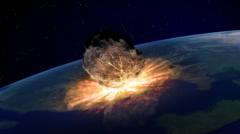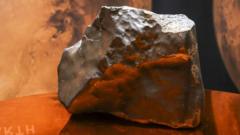A monumental discovery has emerged from a study conducted by scientists exploring the impact of a massive meteorite, known as S2, that struck Earth approximately three billion years ago. First identified in 2014, this enormous meteor, measuring between 40 and 60 kilometers in diameter, produced a staggering tsunami and catastrophic volcanic activity that boiled oceans—events surpassing any recorded in human history.
The lead author of the research, Professor Nadja Drabon from Harvard University, has spearheaded expeditions to the Eastern Barberton Greenstone Belt in South Africa. Here, they scoured the site of the impact for rock samples, utilizing sledgehammers to extract fragments that could illuminate the consequences of this early collision between Earth and space debris.
S2 dwarfed the asteroid responsible for the extinction of the dinosaurs, which measured about 10 kilometers. Researchers believe the impact of the S2 meteorite, with a mass estimated to be 50 to 200 times greater than that of its dinosaur-killing counterpart, caused a crater 500 kilometers wide. Its violent collision led to a maelstrom of molten rock and debris that could’ve circled the globe, obliterating the planet as it was known at the time—a primordial water world with sparse continental landmasses.
Prof. Drabon and her team assembled in remote areas, often accompanied by armed rangers to protect against local wildlife. Their goal was to find spherule particles—tiny remnants of the impact that could provide insight into the pre-and post-impact environment. After painstaking collection and analysis, the research revealed shocking insights: the meteorite's disruptions had actually circulated vital nutrients—such as phosphorus and iron—throughout the oceans, enriching conditions for early microbial life.
This finding contradicts traditional views that catastrophic meteorite impacts primarily result in widespread destruction. According to Prof. Drabon, these upheavals likely fostered resilience within early life forms, allowing them to thrive. The swift rebound of microbes parallels the quick regeneration of bacteria after brushing one’s teeth—when destroyed, they return almost immediately.
Moreover, the S2 impact generated vast amounts of heat, raising ocean temperatures and leading to up to 100-degree Celsius air intensity. While the skies darkened with dust and debris, cutting off sunlight for photosynthetic organisms, the tumult also brought iron-rich water from the oceans' depths, arming early life forms with vital energy sources and encouraging their growth.
In sum, the groundbreaking study opens up new perspectives on the complex history of life on Earth, suggesting that massive meteorite impacts like S2 were not just events of ruin, but potentially significant catalysts for the survival and flourishing of life. The full study has been published in the scientific journal PNAS, adding a fascinating chapter to our understanding of early Earth’s ecological narratives.




















